Anyone who’s been following The Lighting Project or has an interest in Lightning Maroon Clownfishes probably knows that SEASMART fishers were responsible for the two specimens collected in the waters of Papua New Guinea.As released moments ago @ ReefBuilders, the official word today is that EcoEZ’s SEASMART sustainable marine fish collection operations in PNG suffered a setback in the fourth quarter of 2010 as the governmental funding for the program was prematurely withdrawn. Rather than rehash what I wrote at ReefBuilders, please read the article and press release from EcoEZ at ReefBuilders.com.
Needless to say, when I first learned of the shutdown my response was “crap”. Probably followed by “WTF?!”. While I don’t know how long this has been going on, it’s not like operations were suspended today, given that funding was withdrawn at least 3 months before it was supposed to be. Meanwhile, the entire time members of SEASMART had been trying to continue to help with the Lightning Project, obviously despite these obstacles. Of course I’m a patient guy, and I figured at the time that my needs were simply very low on the scale of priority compared to the LA importers. Needless to say, despite everyone’s efforts and my ongoing requests for another large female PNG Maroon Clownfish (and several other items of PNG livestock to help make things worthwhile), SEASMART and their partners were unable to deliver what I had requested in the 4th quarter of 2010. And now I know why.
It’s unknown whether exports will resume in a month, a year, or a decade. Given the uncertain future of SEASMART at this point in time, it means that patiently waiting for the ideal PNG broodstock isn’t a viable option. Therefore, hoping that a large female PNG Maroon will show up is false hope. Hoping for another Lightning Maroon is out. Hoping for any more juvenile Maroon Clowns that show irregular markings is out. All of these possibilities keep me focused on protecting the Lightning Maroon from any external damage while trying to encourage breeding with a large White Striped Maroon Clownfish of unknown origin. Keeping the Lightning Maroon a “male” had many advantages, especially when considering the possibilities of future broodstock.
So ironically perhaps, this turn of events made the forward path of the Lighting Project extremely clear. As always, I’ll share the thought process. First, as of today, here is an inventory of every Maroon Clown in the basement.
1 PNG Lightning Maroon Clownfish, assumed male, paired with 1 XLG “Labrador” White Stripe Maroon almost 6″ in size.
1 PNG Maroon Clown proven male, paired with 1 XLG proven female Sumatran Gold Stripe Maroon, about 5″ in size, actively spawning.
1 Pair of inactive proven spawning White Stripe Maroons from Greg in Iowa, the male having questionable characteristics.
1 lone Medium to Large White Stripe Maroon, Lucy, who is only slightly larger than the Lightning Maroon but has never been with another Maroon. Sex unknown.
1 PNG Maroon Clown, in a 10 gallon QT tank with a RBTA. A second, slightly smaller PNG Maroon Clown resides in a small breeder basket in the same tank.
Most of the non-PNG Maroon Clowns were brought into the program to perform one of two functions. A) Serve as females to keep the myriad of PNG juveniles I had on hand as “males”. B) Serve as a female semi-suitable mate for the Lightning Maroon until a more suitable, PNG-bloodlined Maroon Clown female could be paired with the Lightning Maroon.
With the loss of access to any WC PNG Maroons, the chances of obtaining a large adult PNG female are truly slim to none at the moment. My only source would have to be a PNG maroon that had already been imported. The simple truth however, is that very few, if any owners of PNG Maroons, KNOW that they have a PNG Maroon from the SEASMART program. Any fish I took in would be coming with an extra layer of “doubt” unless the hobbyist owner still had the paperwork documenting the fish as being from PNG. In fact, such documentation is atypical at best to start with.
My only other option to obtain a female PNG Maroon at the moment is to ‘make’ one. In truth, the 2 PNG juveniles sharing the 10 gallon tank have been undergoing my efforts to create a pair for some time now. Since the two fish are the same size and fight when they are introduced, I’ve been feeding the one in the main tank 3 times per day, but feeding the small one only once per day. This differentiation in feed should, over time, produce a significant size difference and ultimately, allow me to pair these two fish. But that could take months or even years. All that time, what about the Lighting Maroon. And what if, just what if, that female doens’t work with the Lightning Maroon? And what if the skeptics have been right..what if the Lightning Maroon in fact IS a female?
Well, perhaps the biggest bit of game-changing information is this. I have only 4 PNG Maroons in my possession at this time. All along, I have planned to establish other normally barred PNG pairs, specifically for the purposes of maintaining PNG bloodlines as well as genetic diversity. The name of the game here – outcrossing. The simple truth now is that there is really only one good route to go that can hit the most goals in the shortest amount of time.
“What now?” is no longer a question of options. The small population I have to work with and the timeframes and risks surrounding any “options” are too great and don’t make sense. The answer is now, for the moment, crystal clear.
The Lightning Maroon will be turning female. She will be paired with the actively spawning PNG male. The male will be introduced to her, not the other way around, in a new tank. Given that the male is actively spawning, hopefully this will be some encouragement for the Lighting Maroon to make a quick sex change and start laying eggs. This could indeed take weeks or months, but it’s the best shot I have if I want to maintain PNG bloodlines.
If that pairing seems problematic, I will be trying the other small PNG “male” that’s in restricted quarters. Whichever PNG male is not paired with the Lightning Maroon will be ultimately paired with the other PNG Maroon that I’ve been encouraging to become female. The net result will be 2 fully unrelated spawning pairs of PNG Maroon Clownfish. This is the largest foundation population I can currently work with, and provides the best genetic diversity I can offer to the program unless other PNG Maroons are identified or collected in the future.
So there you have it. Lightning Maroon will be turning female unless something really crazy happens. Now all I’m waiting on is the Lightning Maroon’s NEW HOME, which seems to have gone missing in FedEx land?
- About The Lightning Project
- Inventory of F1 PNG Lightning and White Stripe Maroon Clownfish
- F1 PNG Lightning Maroon Clownfish, BZLM1
- F1 PNG Lightning Maroon Clownfish, BZLM2
- F1 PNG Lightning Maroon Clownfish, FW1
- F1 PNG Lightning Maroon Clownfish, LM10
- F1 PNG Lightning Maroon Clownfish, LM11
- F1 PNG Lightning Maroon Clownfish, LM12
- F1 PNG Lightning Maroon Clownfish, LM13
- F1 PNG Lightning Maroon Clownfish, LM14
- F1 PNG Lightning Maroon Clownfish, LM15
- F1 PNG Lightning Maroon Clownfish, LM16
- F1 PNG Lightning Maroon Clownfish, LM17
- F1 PNG Lightning Maroon Clownfish, LM18
- F1 PNG Lightning Maroon Clownfish, LM19
- F1 PNG Lightning Maroon Clownfish, LM20
- F1 PNG Lightning Maroon Clownfish, LM3
- F1 PNG Lightning Maroon Clownfish, LM4
- F1 PNG Lightning Maroon Clownfish, LM5
- F1 PNG Lightning Maroon Clownfish, LM6
- F1 PNG Lightning Maroon Clownfish, LM7
- F1 PNG Lightning Maroon Clownfish, LM8
- F1 PNG Lightning Maroon Clownfish, LM9
- F1 PNG Lightning Maroon Clownfish, MD1
- F1 PNG Lightning Maroon Clownfish, MWP3
- F1 PNG Lightning Maroon Clownfish, WS17
- F1 PNG Lightning Maroon, EC1
- F1 PNG Lightning Maroon, GL1
- F1 PNG White Stripe Maroon Clownfish, BZWS1
- F1 PNG White Stripe Maroon Clownfish, BZWS2
- F1 PNG White Stripe Maroon Clownfish, BZWS3
- F1 PNG White Stripe Maroon Clownfish, WS10
- F1 PNG White Stripe Maroon Clownfish, WS11
- F1 PNG White Stripe Maroon Clownfish, WS12
- F1 PNG White Stripe Maroon Clownfish, WS13
- F1 PNG White Stripe Maroon Clownfish, WS14
- F1 PNG White Stripe Maroon Clownfish, WS15
- F1 PNG White Stripe Maroon Clownfish, WS16
- F1 PNG White Stripe Maroon Clownfish, WS4
- F1 PNG White Stripe Maroon Clownfish, WS5
- F1 PNG White Stripe Maroon Clownfish, WS6
- F1 PNG White Stripe Maroon Clownfish, WS7
- F1 PNG White Stripe Maroon Clownfish, WS8
- F1 PNG White Stripe Maroon Clownfish, WS9
- F1 PNG White Stripe Maroon, EC2
- F1 PNG White Stripe Maroon, FW2
- F1 PNG White Stripe Maroon, GL2
- F1 PNG White Stripe Maroon, MD2
- Lightning Breeding Directive
- Lightning Maroon Clownfish Links
- Home
- About The Lightning Project
- Inventory of F1 PNG Lightning and White Stripe Maroon Clownfish
- F1 PNG Lightning Maroon Clownfish, BZLM1
- F1 PNG Lightning Maroon Clownfish, BZLM2
- F1 PNG Lightning Maroon Clownfish, FW1
- F1 PNG Lightning Maroon Clownfish, LM10
- F1 PNG Lightning Maroon Clownfish, LM11
- F1 PNG Lightning Maroon Clownfish, LM12
- F1 PNG Lightning Maroon Clownfish, LM13
- F1 PNG Lightning Maroon Clownfish, LM14
- F1 PNG Lightning Maroon Clownfish, LM15
- F1 PNG Lightning Maroon Clownfish, LM16
- F1 PNG Lightning Maroon Clownfish, LM17
- F1 PNG Lightning Maroon Clownfish, LM18
- F1 PNG Lightning Maroon Clownfish, LM19
- F1 PNG Lightning Maroon Clownfish, LM20
- F1 PNG Lightning Maroon Clownfish, LM3
- F1 PNG Lightning Maroon Clownfish, LM4
- F1 PNG Lightning Maroon Clownfish, LM5
- F1 PNG Lightning Maroon Clownfish, LM6
- F1 PNG Lightning Maroon Clownfish, LM7
- F1 PNG Lightning Maroon Clownfish, LM8
- F1 PNG Lightning Maroon Clownfish, LM9
- F1 PNG Lightning Maroon Clownfish, MD1
- F1 PNG Lightning Maroon Clownfish, MWP3
- F1 PNG Lightning Maroon Clownfish, WS17
- F1 PNG Lightning Maroon, EC1
- F1 PNG Lightning Maroon, GL1
- F1 PNG White Stripe Maroon Clownfish, BZWS1
- F1 PNG White Stripe Maroon Clownfish, BZWS2
- F1 PNG White Stripe Maroon Clownfish, BZWS3
- F1 PNG White Stripe Maroon Clownfish, WS10
- F1 PNG White Stripe Maroon Clownfish, WS11
- F1 PNG White Stripe Maroon Clownfish, WS12
- F1 PNG White Stripe Maroon Clownfish, WS13
- F1 PNG White Stripe Maroon Clownfish, WS14
- F1 PNG White Stripe Maroon Clownfish, WS15
- F1 PNG White Stripe Maroon Clownfish, WS16
- F1 PNG White Stripe Maroon Clownfish, WS4
- F1 PNG White Stripe Maroon Clownfish, WS5
- F1 PNG White Stripe Maroon Clownfish, WS6
- F1 PNG White Stripe Maroon Clownfish, WS7
- F1 PNG White Stripe Maroon Clownfish, WS8
- F1 PNG White Stripe Maroon Clownfish, WS9
- F1 PNG White Stripe Maroon, EC2
- F1 PNG White Stripe Maroon, FW2
- F1 PNG White Stripe Maroon, GL2
- F1 PNG White Stripe Maroon, MD2
- Lightning Breeding Directive
- Lightning Maroon Clownfish Links
Just a real quick update. Late last week I had a holding tank crash out on me, and in the process, one of the spare “PNG” Maroons, the only single one, was killed. I’ve been battling the cold here in this new basement setup – ich has been running rampant as heaters are either failing to keep up, or failing outright. Ambient air temps in the basement tonight are 58F, and every heater in the place is ON!
Meanwhile, another semi-large Maroon was donated to the project by “Damsel Debbie” from down in the Twin Cities area. Lucy is a White Stripe Maroon, maybe 3.5″ long…definitely a fish that will go female if it’s not already. The thought here *might* be to pair Lucy up with the PNG Maroon that’s currently paired with the Jonica’s Gold Stripe….that frees up the Gold Stripe to be mated with a male Gold Stripe (preferable in my book) and will keep the PNG male a male.
I’m heading down the path of trying to pair up the other two PNG Maroons. One is given free reign of the 10 gallon reef and is fed 3 times per day. “Her” potential mate is only fed once per day and is housed in a breeder basket….(these are the Maroons that I showed being introduced a couple months back, where the one in the tank instantly attacked the other one upon introduction). The theory here is that even if I could never find another WC PNG Maroon, I could “create” a female through the pairing. I could also allow the Lightning to go female, pairing it with the small male, which is a safe route to go and keeps the PNG bloodlines clean. It only sacrifices the Lightning being a male, which as I’ve mentioned some people are in full support of making the Lightning the female in the pair.
And so the project goes…slow as always.
I know you’re all excited…well…there WAS a PNG Maroon Clown involved, but it was NOT a “Lightning Maroon”. No, the spawn I found today was between the large Sumatran Gold Stripe Maroon female from Jonica, and one of the small male PNG White Stripe Maroons which I had placed with the GSM to ensure it stayed a male. I’d been noticing that the male would occasionally stay hidden in back, not coming out to feed. This behavior seemed periodic. Nothing else seemed out of the ordinary. The female GSM never became noticeably ripe with eggs. Her aggression level has not increased at all (as you are about to see). I observed NO cleaning behavior other than the female’s constant digging. No, the ONLY thing that changes is the male is becomes “shy”. Being the third or fourth time I’ve observed this periodic shyness, I decided to upturn my live rock, carefully, to see what was going on. Surprise, we have eggs.
Now, even if I raise these, I will do so only to get some practice rearing Premnas larvae. After I’m assured I have it nailed down, any babies I raise from this pairing will be destroyed. It may seem cruel, but the reality is that such “hybrid” larvae are likely to be intermediary between the two variants at best. Some breeders would argue that you could use such methodology to introduce Lightning genetics into a Gold Stripe variety…ultimately creating Lightning Maroons that have YELLOW bolts on them vs. white. No doubt, someday, someone may try that. More realistically, some breeders might argue that such a cross could be used to breed more “docile” genetics into a white stripe form, which is generally deemed more aggressive. While this is true, you lose the natural form along the way – the fish that are uniquely adapted to a location like the reefs of PNG is lost, and you have a man-made creation in its place which might fail to flourish in the wild for who knows what reason. Or if reintroduced fish did survive, they could inadvertently introduce a latent gold stripe gene and one day all of the Maroon Clownfish in PNG would be gold stripes. It’s a slippery slope when we start ignoring the unique traits that make up variants. To take this “cross” to the most extreme, there are indeed people who believe that the Gold Stripe Maroon Clownfish represents a different species from the White-Striped forms (Premnas biaculeatus). There is even a different scientific name that gets floated for the Gold Striped form – Premnas epigramma – by people who believe this. Of course, this name is not currently valid in any sense.
While we may never know exactly where the name Premnas epigramma came from, it is likely a slight derivation of another name, Premnas epigrammata, published by Fowler in 1904. If in fact this name was applied to the Gold Striped Maroon Clown from Sumatra, it could someday become resurrected should someone research, and determine, that the form described by Fowler is in fact distinct from all the other forms. Of course, if Fowler used the name on fish other than the Sumatran Gold Striped form, then that might leave the door open for an entirely new species name to be applied. Ah…the joys of taxonomy. There are actually at least 5 names out there for Premnas species, but all are considered synonymous with Premnas biaculeatus – check ’em out on Fishbase.
Nevertheless, scientists often have it wrong, or perhaps more appropriately, incomplete. Consider Amphiprion barberi from Fiji, which was at first considered a population of the western Australian A. rubrocinctus, but then treated for a considerable time as a color variant of the Cinnamon or Dusky Clownfish, A. melanopus. Only recently was this species recognized as distinct through genetic analysis, which confirmed the truly unique nature of the species. Of course, this multi-decade “misidentification” calls into question the “pedigree” of every fish in the trade as “A. rubrocinctus“, not to mention the voracity of some captive bred Tomato (A. frenatus) and Cinnamon Clownfish which could very well be hodgepodges of 2 or even 3 species of fish. Heck, there area already breeders who knowingly sell what should be called Percularis (the hybrids of the Common Clownfish (A. ocellaris) X the Percula Clownfish (A. percula)) as run of the mill common Ocellaris Clownfish. The worst breeders do so intentionally. Others may be mislead by vendors who can’t even tell the two species apart and don’t even bother to make corrections when the problems are pointed out to them (for history’s sake…that link points to a pairing of what I strongly believe is a female Percula with a male Ocellaris, being sold as a “True Percula Breeding Pair” and yes, I emailed the vendor about those and other mislabled pairs over a week ago – I am disappointed).
Interestingly though, talented hobbyists and breeders sometimes see differences where a scientist focused on morphology does not. One of the best examples is the Darwin Black Ocellaris, which is so fundamentally different in breeding from the common orange Ocellaris Clownfish that we treat this variant as a separate entry in a more difficult class for scoring in the Marine Breeding Initiative. The Maroon Clownfish actually shows some similarities in this regard. Gold Stripes are generally relatively more peaceful, whereas White Stripes are generally considered downright vicious by most hobbyists and breeders (who have hard times keeping the juveniles from rendering all the fish in the batch too torn up to sell!). Interestingly, through my own informal observations, it seems that Gold Stripe Maroons are particularly prone to losing their stripes as they mature, and this pattern of loss seems consistently from the bottom up. It seems conversely that White Stripe Maroons may in fact NOT lose their stripes as they age, but be more more prone to darkening of the stripes. It is differences such as these that are suggestive that in fact, there may be more subtle differences yet to be uncovered, and in fact, we may find we’re dealing with 2 species, and not one.
So…enough of my ranting for now. For the record, the female Gold Stripe Maroon was brought in on 7-10-2010, and it is safe to say she spawned by maybe 11-28-2010, although I suspect there had been a few spawns prior…maybe as far back as 2 months ago. Still, it just goes to show you that even when the fish are mature, clownfish are not “quick” to spawn. And thus, the Lightning Project continues to be a big, long waiting game.
So consider this your introduction to one of the other several Papua New Guinea (PNG) Maroon Clownfish (Premnas biaculeatus) running around my basement these days. I was taking some pictures for a forthcoming article in the new UK magazine Marine Habitat and I wanted to show up a “sustainably” harvested fish…thus, images of a SEASMART PNG Maroon Clownfish seemed appropriate. It seemed overly boastful to take more images of the Lightning Maroon, so instead, I opted to photograph one of the maroons who’s life is currently restricted to a small breeder basket type arrangement in the hopes that it winds up male (with the other PNG Maroon hopefully to become the female). Amazing how much these fish have all changed colors since arriving months ago…in a future installment, I should photograph and name them all. But for now, here’s a smaller PNG Maroon Clownfish debuting in a several image spread. BTW, apparently, the gallery links to FULL SIZE images…suitable for desktops among other uses…
Yeah…this is one of those times where no news is relatively good news. I’m in need of some Lightning Maroon Clownfish updates! Where to begin?
How about the new pair of Maroon Clowns I got from Greg a while back. He had them spawning, but they’ve yet to spawn since arriving…I picked them up from Greg on September 19th, 2010 if memory serves right. 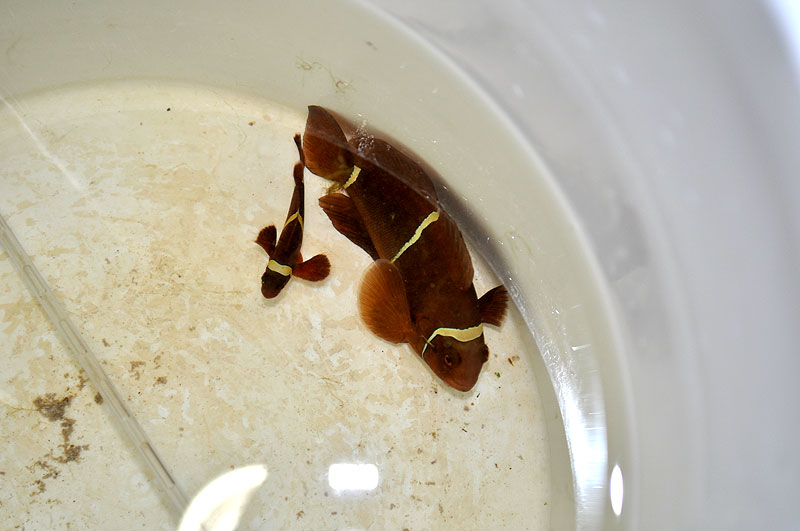
I’ve been watching this pair for a while. The female is a white stripe, “The female was purchased at Fish and Pets (defunct ) in Rochester, MN.” according to Greg. The male appears, on some levels, to look like it might be a Gold Stripe, or perhaps maybe a cross with a Gold Stripe. I’ve done some preliminary work with Greg to nail down where the male came from, and so far the best answer we’ve come up with is a breeder who was selling maroon clowns at a frag swap in Madison, WI, maybe 1.5 years ago. Working on getting a better answer…I’d like to find out more about the male’s lineage, just for my own reasoning.
The main reason for picking up this pair was to possibly do some rotating. First, get the fish back into the swing of spawning, which 2 months in has yet to happen (not surprising). Once spawning, I could conceivably use this actively spawning white stripe female as a possible mate for the Lightning Clown, at least to get the ball rolling. I could also use the male as a placeholder, or the female as a placeholder, to help force sexes on the other PNG maroons I have on hand currently. Sadly, EVERYTHING remains in limbo at this moment…lots of maroon clowns floating around and yet nothing really going on.]
The Gold Stripe female that I picked up a few months ago continues to live happily with her PNG male. At this point, were I to opt to push the Lightning Maroon to become a female, the white stripe male with the Gold Stripe female would be the choice. Still, if I really take my time, I could force one of these other PNG juveniles to become a full blown female, at which point I could use it with the Lighting Maroon (again, assuming the Lightning remains male through all of this). Meanwhile, this pair *might* be spawning…the male sometimes disappears for days on end, which is suggestive of nest tending, although I haven’t found any nests nor have I observed the female Gold Stripe Maroon to get “ripe” and then look “spawned out”. So officially, despite having 9 different Maroon Clownfish in the basement, I don’t have ANY spawnings occuring in any of the pairings.
I’ve put in a special request with David and Mark @ SEASMART. I asked them specifically to try to find me another large female from Fisherman’s Island and to have it shipped direct if possible…keeping it in the chain of custody as little as possible. Along with that, they’ve had some nice small males show up with abberant markings. Foregoing any outside chance of finding yet another Lightning Maroon, a male with these markings might be indicative of possibly a genetic predisposition, or even going so far as to suggest that perhaps these are ultra-low-grade examples of a wide continuum of Lightning Maroon mutation. Of course, this all remains on the horizon.
I have also been patiently awaiting the arrival of a new home for the Lightning Maroon and its future mate. I’ve been keeping this very hush hush, primarily because I don’t want to jynx it! Of course, a couple weeks back, the tank was finally on its way only to be crushed by the freight carrier. Back to waiting. What I will say is that the ultimate home of the Lightning Maroon will be the nicest and most modern tank I own when it’s all said and done. I hope furthermore to deck it out to showcase exclusively the marinelife of PNG as presented by the SEASMART program. I have also decided to go back to the drawing board and be schooled in SPS husbandry by my friends Jay and Frank, who clearly do worlds better with their SPS than I ever have. Of course, SEASMART isn’t even planning on releasing corals from the mariculture program for at least another couple weeks (last we all heard, December 2010), so there is still time to plan for all this.
And that sums it up for the moment. We all knew this was going to be a very long, drawn out project, so it should come as no surprise that things have been quiet for a while. Even I must admit, the waiting is starting to get to me…I really want SOMETHING to happen. Then again, I look at the pair of Fire Clowns, Amphiprion ephippium, that have been “working on it” for over a year now and have not yet spawned either. Clownfish just take time. Pair of Black Ocellaris took 4 years. So, nothing here is gonna be rushed. If I don’t post again before the end of November, a happy Thanksgiving Holiday to all the US readers!
It’s been 6 months since SEASMART, Pacific Aqua Farms, Blue Zoo Aquatics and Fed Ex all brought the PNG Lightning Maroon Clownfish to my doorstep. The Lightning Project continues at the typical clownfish pace…glacially slow. I thought this might be time to reflect…
For a while I kept a list of urls where discussions would turn up. It is MASSIVE! It’s interesting to look back from months later and see all that was said at the time. Some of the things I found most interesting are all those things that folks got wrong and how much information out there conflicts or just downright fundamentally untrue. A new surprise that I hadn’t read before, apparently someone bought the rights to breed this fish and has two. I must meet this man…
Here’s a slew of the links, including a few more recent ones, a few where the Lightning isn’t the primary subject, and a few about the first Lightning Maroon collected in 2008. Posts are in alphabetical order – I’ll be adding this jumble to the links page as well! If you know of one I’m missing here (or find anything broken), please post it to the comments and I’ll add / fix it!
http://aquatic-terrors.com/forums/index.php?showtopic=16247&pid=156363
http://blog.aquanerd.com/2010/03/lightning-maroon-clownfish-now-available.html
http://blog.aquanerd.com/2010/03/lightning-maroon-clown-for-sale-on-blue-zoo.html
http://blog.aquanerd.com/2010/04/the-lightning-project-site-dedicated-to-the-lighting-clown.html
http://dfwmas.org/Forums/viewtopic.php?f=2&p=564858
http://forum.marinedepot.com/Topic108423-12-1.aspx
http://glassbox-design.com/2010/lightning-maroon-clownfish-png/
http://glassbox-design.com/2010/tailless-clownfish/
http://indmas.org/main/index.php?showtopic=5898
http://nationalcoralregistry.com/forum/showthread.php?746-Have-YOU-seen-the-lightning-maroon-YET!&p=10388&viewfull=1
http://reborn.bbmg.com.sg/?p=11
http://reefbuilders.com/2008/09/21/wicked-maroon-clownfish-emerges-from-the-png/
http://reefbuilders.com/2010/03/29/lightning-maroon-clownfish-papua-guinea-appears-blue-zoo-aquatics/
http://reefbuilders.com/2010/03/30/lightning-maroon-clownfish-from-blue-zoo-aquatics-will-be-entrusted-to-an-accomplished-fishbreeder/
http://reefbuilders.com/2010/04/13/lighting-maroon-clownfish-pairing-videos/
http://reefbuilders.com/2010/07/02/lightning-maroon-clownfish-stars-hd-video/
http://reefbuilders.com/2010/08/31/lightning-maroon-clownfish-date/
http://reefbuilders.com/2010/09/07/matt-pedersens-macna-xxii/
http://reeftools.com/news/lightning-maroon-clownfish-pairing-video/
http://reeftools.com/news/lightning-maroon-clown-sold-on-blue-zoo/
http://www.3reef.com/forums/tropical-fish/lightning-maroon-clownfish-96209.html
http://www.aquariacentral.com/forums/showthread.php?t=223523
http://www.acuaristica.com/blog/2010/04/pez-payaso-marron-rayo-premnas-biaculeatus-de-papua-nueva-guinea/
http://www.area191.net/smf/index.php?topic=1596.0
http://www.bluezooaquatics.com/productDetail.asp?did=11&pid=5929&cid=331
http://www.bluezooaquatics.com/resources.asp?show=416
http://www.bostonreefers.org/forums/showthread.php?96214-PNG-lightning-maroon-clownfish
http://www.canreef.com/vbulletin/showthread.php?t=62936
http://www.fishforums.net/index.php?/topic/325667-a-must-see-a-lightening-clownfish/
http://www.greateriowareefsociety.org/Community/DiscussionForums/tabid/78/aft/17003/Default.aspx
http://www.greateriowareefsociety.org/Community/DiscussionForums/tabid/78/afv/topic/aff/4/aft/19178/Default.aspx
http://www.greateriowareefsociety.org/Community/DiscussionForums/tabid/78/aft/19199/Default.aspx
http://indmas.org/main/index.php?showtopic=5898
http://www.ipaq.org.br/modules.php?name=Forums&file=viewtopic&t=46797
http://www.jolietareareefclub.com/forums/showthread.php?t=4034
http://www.livingreefs.com/lightning-maroon-clownfish-t25360.html
http://www.manhattanreefs.com/forum/fish/46208-new-hybrid-maroon-clownfish.html
http://www.manhattanreefs.com/forum/general-discussion/76118-new-ora-clown-strains.html
http://www.manhattanreefs.com/forum/want-buy/75708-wtb-png-lightning-maroon-clownfish.html
http://www.marshreef.com/modules.php?name=Forums&file=viewtopic&p=338055
http://www.masa.asn.au/phpBB3/viewtopic.php?f=46&t=218823
http://www.masm.org/mForums/tm.aspx?&m=37446&mpage=1
http://www.nano-reef.com/forums/index.php?showtopic=231947&hl=rarest&st=0
http://www.nano-reef.com/forums/index.php?showtopic=232473&hl=lightning
http://www.nano-reef.com/forums/index.php?showtopic=232084&st=0
http://www.nano-reef.com/forums/index.php?showtopic=233463
http://www.nanoreefblog.com/nano-reef-news/captive-bred-mandarins-lightning-maroon-and-gladiator-clownfish-and-dwarf-dartfish
http://www.njreefers.org/joomla/index.php?option=com_smf&Itemid=26&topic=23813.msg212513#msg212513
http://www.ocean-wonders.co.uk/messageboard/content.php/168-The-2500-Maroon-Clown
http://www.rareclownfish.com/forums/f15/lightning-maroons-3896/
http://www.rasoc.org/forums/showthread.php?t=13455
http://www.reef2reef.com/forums/fish-breeding-forum/40767-lightning-project.html
http://www.reef2reef.com/forums/general-reef-discussions/40171-check-out-lightning-maroon.html
http://www.reef2reef.com/forums/fish-discussion/40150-lightning-maroon.html
http://www.reefaddicts.com/content.php/205-On-Location-with-the-SEASMART-Program-from-PNG?commentid=1029
http://www.reefcentral.com/forums/showthread.php?t=1823970
http://www.reefcentral.com/forums/showthread.php?t=1826120
http://www.reefcentral.com/forums/showthread.php?t=1824222
http://www.reefcentral.com/forums/showthread.php?t=1831681
http://www.reefcentral.com/forums/showthread.php?t=1489494
http://www.reefcentral.com/forums/showthread.php?t=1824961
http://www.reefcentral.org/forums/showthread.php?t=1825724
http://www.reefcentral.com/forums/showthread.php?t=1903804
http://www.reefkeeping.ca/forum/showthread.php?345-Blue-Zoo-Lightning-Maroon-Clownfish
http://www.reefnews.eu/?p=2049&lang=en
http://www.reefs.org/forums/topic135584.html
http://www.reefs.org/forums/topic123228.html
http://www.reefsanctuary.com/forums/saltwater-fish/57663-lightning-maroon-clownfish-blue-zoo-aquatics.html
http://www.reefsmagazine.com/showthread.php?t=75708
http://www.rettalbot.com/onassignment/PNG.html
http://www.seasmart.ecoez.com/lightning-maroon-clownfish.html
http://www.smmas.org/vb/showthread.php?t=1947
http://www.talkingreef.com/forums/clown-fish/10374-show-stopper-clown-collected-papua-new-guinea.html
http://www.tcmas.org/forums/showthread.php?t=25747
http://www.tcmas.org/forums/showthread.php?t=26178
http://www.tcmas.org/forums/showthread.php?t=25958
http://www.thavysreng.com/?p=276
http://www.theokaa.org/vb40/showthread.php?8140-Lightening-Clownfish
http://www.thereeftank.com/forums/f181/lightning-clown-146033.html
http://www.thereeftank.com/forums/f234/new-ora-clownfish-154299.html
http://www.tropicalfishkeeping.com/saltwater-fish/captive-bred-mandarin-dragonets-45102/
http://www.uberfrags.net/forums/showthread.php?6587-The-ongoing-saga-of-the-PNG-Lightning-Maroon-Clownfish-Breeding-Project
http://www.ultimatereef.net/forums/showthread.php?t=378916
http://www.wamas.org/forums/topic/36414-5000-lightening-maroon-clownfish/
http://www.wamas.org/forums/topic/36683-more-on-the-lightning-maroon-clownfish/
http://www.worldwidereefers.com/forums/showthread.php?5233-Wow!
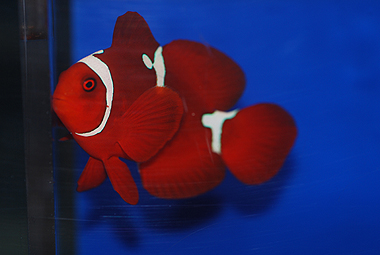
A view of the left flank of the "Funky" PNG Maroon from Blue Zoo - courtesy Mark Martin, Blue Zoo Aquatics
This is a short post – Mark Martin showed me this fish last night, I passed on the premise that if it’s genetic, it seems to be a bit more like a “Picasso” type variant than the “Lightning” variation. I really think that there is a running theme here. It’s juts a theory, but it would seem that the same basic “overbarring” mutation, called “Picasso” in Perculas and “Snowflake” in Ocellaris, is also showing up in Maroon Clownfish now. It would make sense that the genetic of the stripes are all pretty similar among clownfish, and thus, an aberration in a single gene could create the same basic mutation and expression of that mutation across individual clownfish species. Now, we do know that Maroon Clowns are notrious for stripe abnormalities in cultivation anyway, so it’s definitely hard to say what is genetic and what is not.
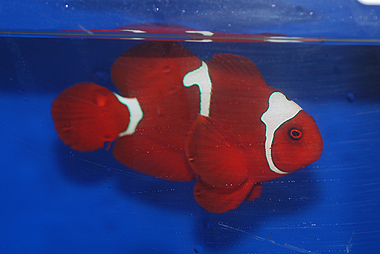
A view of the right flank of the "Funky" PNG Maroon from Blue Zoo - courtesy Mark Martin, Blue Zoo Aquatics
At any rate, go grab that Funky Maroon for $39.95 at Blue Zoo, truly a steal – http://www.bluezooaquatics.com/productdetailcc.asp?did=11&cid=360&pid=8592
There are more funky maroons like this coming out of PNG via SEASMART…everyone should remember the “Morse Code” Maroon I tried but lost to disease (mouth rot). Mark Schreffler sent me some other great pics of fish they’re calling “Horned” Maroons…any of these could carry the secret to unlocking the Lighting Maroon mutation. I’ll update this same post with images if/when I have the proper blessings from their authors! Stay tuned….
And here they are! All images below are copyright 2010 SEASMART, and may not be reused or reproduced in any fashion without the written consent of SEASMART!
Thanks again to Mark Schreffler & SEASMART for allowing me to share these images with the readers of The Lightning Project!
One of the highlights of my trip to MACNA in Orlando this year was getting to meet many of the people who were involved in bringing the Lightning Maroon Clownfish from PNG to my home aquarium in Duluth, MN. While I documented this trip already in my 2010 MACNA recap on Reefbuilders, I wanted to elaborate and do something complimentary here.
I must admit that having been put in contact with David Vosseler by Ret Talbot, I’ve had the opportunity to share my questions, comments and concerns about PNG SEASMART in the past few months over email. I must say, the conversation has admittedly been relatively one-sided and tangential to other discussions I’m having at the time. For example, I still think that in the grand scheme of things, there is a big “fatal flaw” to the notion that a sustainable wild harvest industry will provide sufficient conservation and preservation of coral reefs. I say this, not because I don’t believe in sustainability, but rather because I don’t feel that sustainability is enough. Specifically, a sustainable wild harvest can defend a coral reef from localized issues such as shoreline or “upstream” development problems. It can protect a reef from dynamite fishing or other heavy impact fishing for sustenance. However, a sustainability program like SEASMART cannot directly stand in the way of ocean acidification or coral bleaching from rising ocean temperatures as a result of climate change.
I can’t say I ever got a response from David Vosseler regarding this “fatal flaw” of sustainability, but I simply take that as an acknowledgement of the problem and the reality that SEASMART isn’t meant to address climate change or ocean acifidification. No, it’s meant to create value to the local owners of the resource, as I learned that each village owns its own reef and ultimately decides how best to utilize that resource. What is perhaps most promising is that this program was actually started not by a private individual looking to plunder a developing nation, but with the cooperation and blessing and integral support of the government of Papua New Guinea itself.
Perhaps I’m getting ahead of myself, but I have to say that MACNA provided me the opportunity to meet with MANY people working in the SEASMART program as well as some of the government officials responsible for this program. The first person I met on Saturday afternoon was Simeon Daple (a SEASMART FMA Team Leader and RAM Scientist) who told me about the PNG lifestyle and his hopes for this program. Of course, the conversation took a turn when someone else (I think David’s wife Judy) recognized my name and realized that I was the person who has the Lightning Maroon. Admittedly, I was a bit caught off guard and felt a bit like a celebrity, especially with Selma Pamolak, another FMA Team Leader and RAM Scientist, asked to have her picture taken with me. Somewhere in the shuffle I got to meet Mark Schreffler (Communities & Market Development, Eco-EZ) and Philip Sokou, yet another FMA Team Leader and RAM Scientist. I gotta say, Philip really struck me with his enthusiasm and energy. He’s someone to keep an eye on, and someone I wish I had gotten to spend more time with.
In the short conversations I got to have with everyone from SEASMART that afternoon, I quickly realized just how much of an impact the PNG Lightning Maroon Clown had made not only on the marine aquarium world, but on the team @ SEASMART. The fact that the Lightning Maroon graced the SEASMART T-Shirt should have told me how famous the fish was. I must have told the story at least 3 or 4 times on Saturday of how I had let the Lightning Maroon go on its “first date” with the big Maroon Clown and how it went. Ironically, the reality I took away from this was very simple. My home is the USA residence of a very prominent PNG / SEASMART ambassador. It’s an honor to be charged with the care of this creature, and since the fish cannot speak itself, it’s my job to speak on its behalf. While I already do that with the website, it was definitely exciting to talk about the breeding prospects for this fish with everyone I met from SEASMART on Saturday.
Of course, I did finally get to meet David Vosseler, SEASMART Program Director, face-to-face. I couldn’t have met a more warm, optimistic man. I NEED some of that optimism…David do you bottle it? Of course, I mentioned some of the “tough questions” I’ve asked him in the past and explained where I was coming from, but quickly, again, the conversation moved to Lighting Maroons! There is just never enough time to talk. Fortunately for me, and for many of the other people who approach a program like SEASMART with cautious and healthy skepticism, David Vosseler was the MACNA Banquet Speaker. As a speaker, there is no higher honor than to be asked to present to a truly captive audience of over 1000 people. Talk about pressure.
Well, I have to say, David’s presentation on SEASMART was exceptional. He didn’t bore us with dull figures and a long lecture. No, he hit all the truly key points and explained how the program works within the unique culture of Papua New Guinea. What David may not know is that some of my other very hard questions, including one about the fledgling PNG coral mariculture program, were fully and adequately answered in this presentation. Yes, there were people who saw this presentation and felt they were being “pitched” or “sold to”, but to that end, I have to say if you felt you were being “persuaded” it’s because you were. The arguments put forth were BEYOND compelling.
Like I said, David didn’t drone on for an hour or longer with some boring presentation. Instead, after maybe 15 minutes of talking, he brought a 30 minute video directly from PNG of the SEASMART program in action. It covered the entire process start to finish. Of course, the surprise of the night was seeing the PNG Lightning Maroon Clownfish featured for almost a full minute in the video. Well, actually, that wasn’t the surprise. The surprise was when the fish hit the screen, the entire room, over 1000 strong, erupted in applause. Brian Blank says it was a standing ovation. For a fish. That is now living in my basement. And has its own website. All of which leads me to ask “what the hell was I thinking?”! Talk about a feeling of renewed pressure!
Sunday I was due to depart at 1:00 PM, which left me just enough time to catch a couple more presentations. At 12:00 PM, I had to make the very tough decision between Ret Talbot’s talk on PNG and Ken Nedimyer’s talk on the Coral Restoration Foundation. Honestly, were it not for the fact that Ret and I have chatted online for what feels like a couple years at least, we had only shaken hands the entire weekend and had never met before. So of course, friendship, and PNG, win out over Ken. Sorry too Ken, because I really, really, really wanted to be in your talk too – you’re doing very important work, keep it up!
So yeah, Ret’s talk on his trip to PNG provided another perspective on the country, the people, and the SEASMART program.
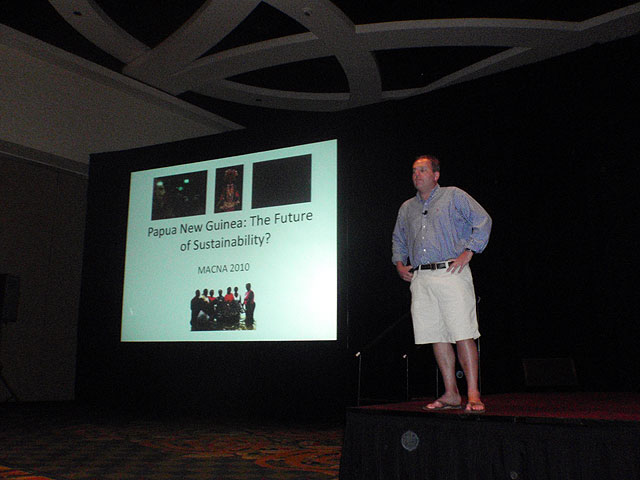
I even got to learn about the true home of the Lighting Maroon Clownfish, SEASMART’s first Fishery Management Area, known as Fisherman’s Island!
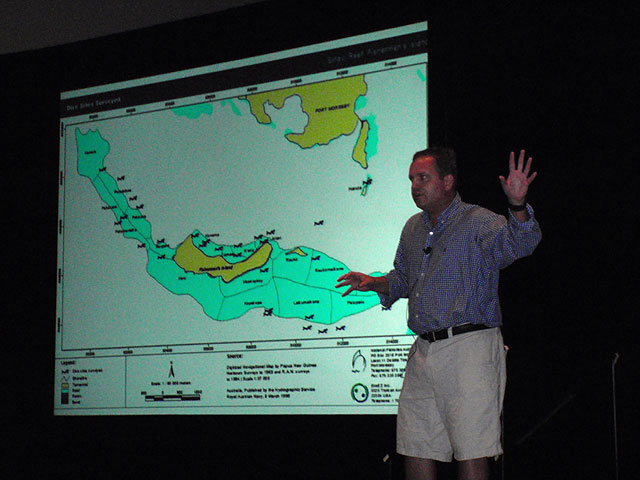
Of course, it figures that I’d be sitting in the front row snapping a picture when he puts up a slide of the Lightning Maroon and points at me! I wish I had a better camera with on this trip, but we captured the moment!
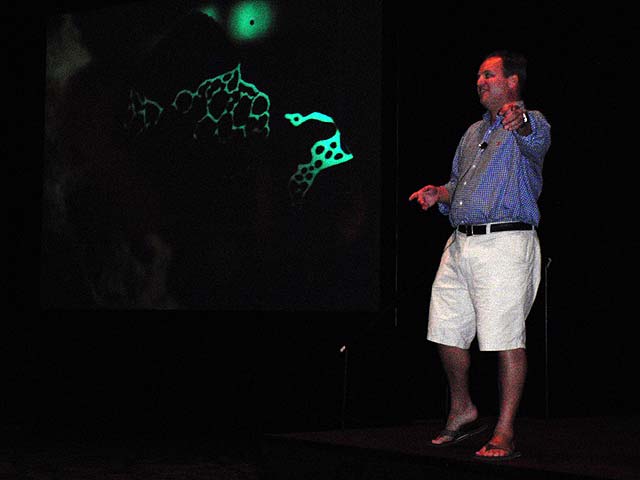
If there’s one thing I could say about Ret’s talk – bring him and David out to your local club events and have them give their talks together…perhaps Ret’s first, and then David’s. We’re at a time in our hobby when we need to think more about where our fish come from (I’ve seen talks on that topic from Richard Ross and Kevin Kohen as well), and we’re at a time when we need to talk more about the sustainability of our wild collection (another good person to talk to about alternatives to traditional collection might be Matt Carberry of Sustainable Aquatics, and their revisiting and promoting of “grown out” tank-raised juveniles offered under the Sustainable Island brand).
After Ret’s talk I actually got to meet several more people although my time was really limited (a ride to the airport with Tom Frakes was waiting for me at 1:15!). I still remember once agian telling Bede Tomokita about the Lightning Maroon’s “first date” the week prior, and expressing my hope for the SEASMART program to continue strongly. There was one big thing I wasn’t going to leave without, and that was this picture below. Everyone from PNG and the SEASMART program left you filled with hope, optimism, and a deep desire to see this project succeed.

Back Row, from left to right:
Bede Tomokita – PNG National Fisheries Association (NFA) Board director representing the Commerce and Industry Dep’t
David Vosseler – SEASMART Program Director
Simeon Daple – Fisheries Management Area (FMA) Team Leader and Resource Assessment and Management (RAM) Scientist
Paul Nivori – PNG NFA Board Chair
Matt Pedersen (“me”) – 2009 MASNA Aquarist of the Year and very humble Lightning Maroon Clownfish caretaker
Felix Tapie – Fisheries Minister’s First Secretary
Kawoi Songoro – PNG NFA Baord Director representing coastal fishers
Ret Talbot – MACNA presenter, CORAL author, journalist and editor, all around cool fish dude 🙂
Front Row, from left to right:
Philip Sokou – FMA Team Leader and RAM Scientist
Selma Pamolak – FMA Team Leader and RAM Scientist
Jordan Ross – SEASMART Volunteer (makes me think of the unpaid interns in The Life Aquatic)
SEASMART as a project is only slated to go through something like the end of this year since it’s a trial project funded by the government. The message we walked away with was BUY PNG FISH…this program needs to show profitability to continue! Of course, I’m always a proponent of voting with your wallet. PNG fish are available through multiple wholesalers / importers. If you want SEASMART fish, you need to ask for them. Some of the key points include all hand caught, all caught in less than 5 meters of water (no risky deep diving, it’s safe for fishers). Fish are held in the ocean after collection, on site, and are screened before they ever enter the supply chain. Those that don’t make the grade (i.e. could be something as simple as a split fin) are returned to the reef.
More than one person left that weekend mentioning that they were so inspired that they wanted their entire tank to come from PNG. I have a project in the works and it will be a PNG biotope aquarium, the future home for the Lightning Maroon and his ultimate mate. I’ve sent a request for information up the chain to Mark Schreffler,who I know is busy, but hopefully in the coming weeks and months we can talk more about what a PNG Biotope tank filled with SEASMART critters might be!
And to the government of PNG, I’ll send this open request. Please do not let this project go unfunded. This is a starting point, critical mass is just starting to form. Do not pull the rug out from underneath and leave us all scratching our heads. Everyone outside wants to see this project work and more specifically, wants to see your citizens derive the most benefit with the least impact. I personally want to know that the person who collects my fish is doing so in a safe, non-impactful manner, bringing me a high quality fish, and all the while being WELL-PAID to do so. We’ve all heard what we think are the right things being said and done as part of the SEASMART program, but we need to see it continue. Efforts like this take time. SEASMART is clearly employing many PNG natives (I see over 40 on the SEASMART Team Pages). It is creating jobs in PNG, but in the worldwild Marine Aquarium Trade it is also creating a lot of hope for a shining example of a new, better way to get our livestock and create local value, and thus an incentive to preserve coral reefs, in the process.
Frankly, I’m not convinced that such a program should ever be handed over solely to private hands. No, I kind-of like that the government is involved and working with the scientists to set catch limits and such. This partnership and collaboration, where the government works together with the people to create and regulate this trade for the long term benefit of the resources and the local community stakeholders is a very good idea. I suppose there’s another open letter to David Vosseler in the making, with the question “how does SEASMART continue to do what it does if it becomes a private entity, and how does that open up the trade in PNG to other, less responsible operations?” I chuckle, because I think I’ve already put enough on David’s plate for the month with some special requests..better let the guys @ SEASMART do their jobs and continue to secure this trade for the long term benefit of PNG and the local stakeholders in each costal village!
In closing, it was the people of PNG that truly impacted me in a way I can’t quite put my finger on. I certainly want to visit, to see this program for myself. I hope my path might cross with Simeon, Selma and Philip again, and that perhaps I might see their PNG home from their point of view, that I might have a deeper appreciation and connection. While I may or may not ever travel to PNG, you could say that I’m a bit smitten with it still weeks after the fact. That is only the result of the fine folks of SEASMART and PNG.
So, two totally unrelated comments to make quickly tonight. First, I really think my suspicions of a fin nipper are correct. Why? Because a new chunk showed up missing from the TOP of the Lightning Maroon’s right pectoral fin. I’d be a lot more worried if there wasn’t also a chunk missing from the tail of my female Mandarin and multiple chunks removed from the fin edges of the 6″ long Labrador Maroon, the undisputed boss of the tank. I can only assume that one of the Bristletail Filefish, probably the male, has gotten into a bad habit of fin nipping. It is conceivable that this could tie in with increased reproductive activity or something. Regardless, I am now thinking about where I can house this pair of fish. GRR!
I also wanted to point the readers to check out the post by Jake Adams on Reef Builders today regarding ORA’s “misbar” Maroons – http://reefbuilders.com/2010/09/13/misbar-maroon-clownfish-showed-ora/ – certainly a fundamentally different stripe mutation (again, only guessing that it’s genetic but I think it is). Arguably very similar to the Picasso Perc and Snowflake Ocellaris, both of which I think are the “same mutation” as it appears on 2 different species, and now here it is again on a Maroon. Very interesting, but again, all this about genetics is just speculation at the moment.
So…another day goes by and I’ve noticed the following – not only has the Lightning Maroon’s right pectoral fin become damaged, but so has his right ventral/pelvic fin. It looks to be about the same age as the other damage judging by the condition. Neither appear to be fresh, and nothing seems to have spread. Seeing damage on multiple fins really had me thinking “fin rot” until I noticed something else…
The female Bristletail Filefish, Acriecthys tomentosus, has a few chunks missing from her tail. I think I’m starting to piece things together…I *think* that the male Filefish may be getting a bit nippy with his tankmates. Certainly, it is conceivable that the fins damaged on the Lighting Maroon were “accessible” to an inquisitive Filefish, which can easily get it’s nose inside the cage through the larger openings in the eggcrate. These fins would easily be exposed if the Lightning Maroon was resting in the back corner as it sometimes does.
Still, taking no chances, a second dose of Maracyn SW went into the tank tonight. I will be keeping an eye on the filefish to see if I catch them in the act at all. I’m back on the fence of how I intend to proceed mate wise, and looking forward to a time when the Lightning doesn’t have to be sequestered in a protective cage (which seems to have failed at its job anyway)!
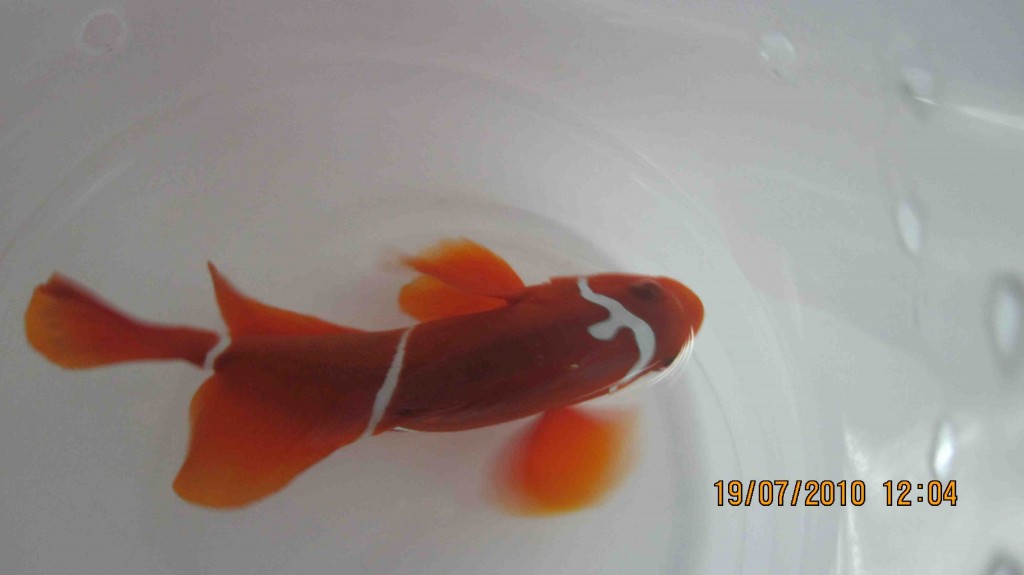
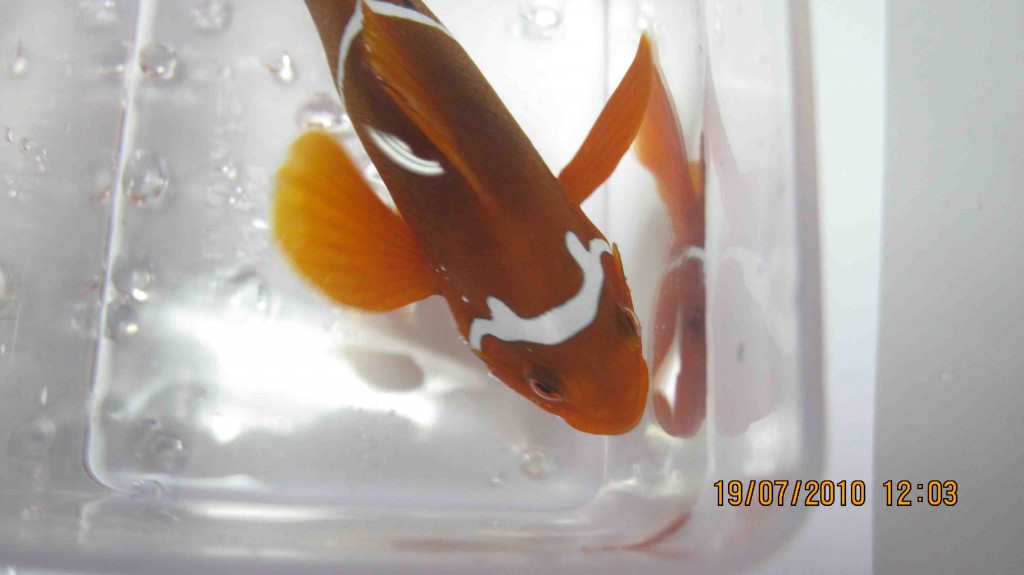
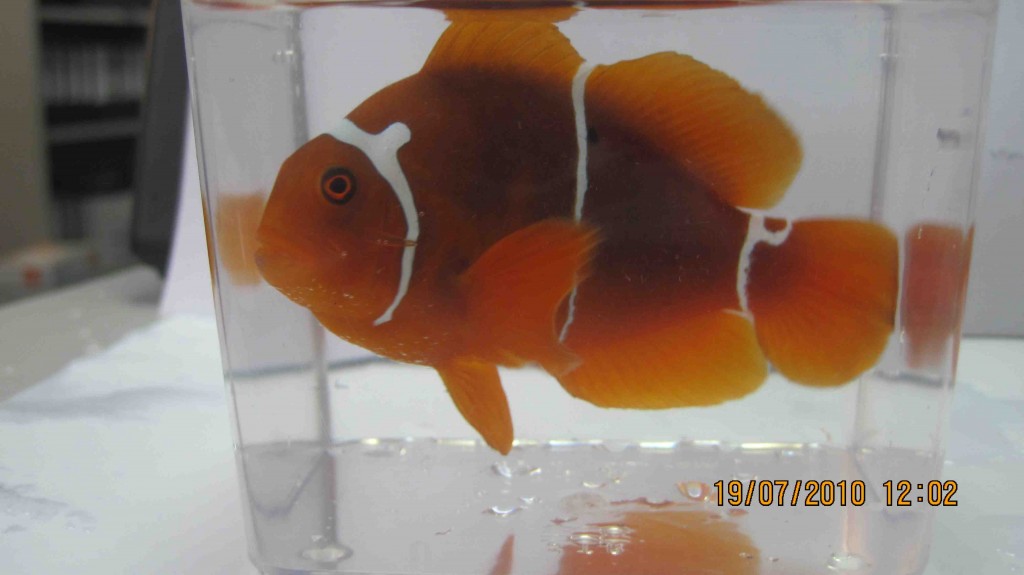
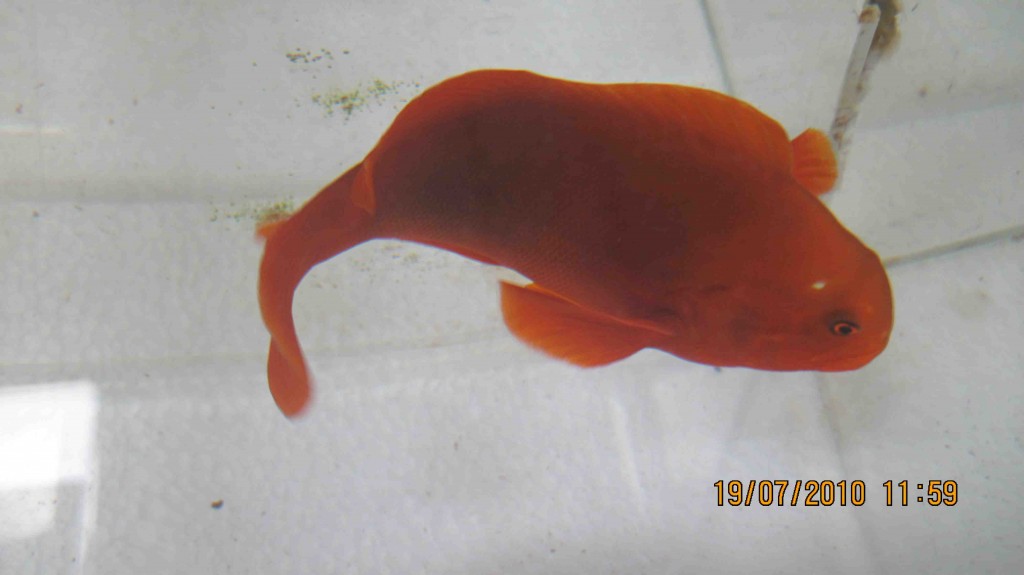
Recent Comments